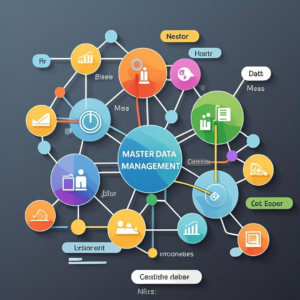
Master Data Management for a Data Mesh
In a decentralized data mesh, data governance plays a crucial role in maintaining data integrity, security, and accessibility. One of the core components of effective governance is Master Data Management (MDM), which ensures that foundational data entities remain accurate, consistent, and reliable across an organization. Without a structured MDM approach, decentralized teams may create redundant or conflicting data, leading to inefficiencies and poor decision-making.
This blog explores the significance of MDM in a data mesh, the challenges it addresses, common design patterns, MDM architectures, and the decision-making process of whether to build or buy an MDM solution.
Understanding Master Data in a Data Mesh
Master data refers to critical non-transactional entities such as customers, products, suppliers, and locations. These entities are used across different departments and provide essential context to transactional data.
In a data mesh architecture, data ownership is decentralized, meaning multiple teams manage their versions of master data. This fragmentation can lead to inconsistencies, redundancies, and inaccuracies. Without proper data governance, data integrity suffers, impacting business intelligence, decision-making, and operational efficiency. A robust MDM strategy ensures that all teams work with a single source of truth while maintaining decentralized control.
For example, if two teams store customer information differently, it may result in duplicate records and unreliable reports. To prevent this, organizations must establish an MDM framework that enforces standardization and ensures that all teams work with a single source of truth.
The Importance of a Single Source of Truth in Data Governance
A single source of truth (SSOT) is essential for ensuring that all stakeholders use consistent and accurate data. However, in a data mesh environment, maintaining SSOT can be challenging due to decentralized data ownership. If different teams define master data inconsistently, it can create duplicate records, errors, and mistrust in data.
For example, if one team refers to a customer as “John Doe” while another records “Doe, John,” data discrepancies arise. This inconsistency can negatively impact analytics and customer experience. A strong MDM framework enforces data governance policies, ensuring that master data remains uniform across all domains.
Causes of Discrepancies in Master Data
Several factors contribute to inconsistencies in master data within a data mesh:
1. Inconsistent Naming Conventions: Different teams may adopt varying standards, causing duplication.
2. Data Migration and Duplication: Data copied across multiple systems may be modified independently, leading to inconsistencies.
3. Lack of Governance: Without clear data governance policies, teams may manage master data differently, affecting data quality.
4. Integration Challenges: Systems with different data models and formats create discrepancies.
5. Human Error: Manual data entry and updates introduce mistakes, leading to incorrect master data.
By implementing a strong data governance strategy, organizations can reduce these discrepancies and ensure master data consistency across all domains.
MDM Design Patterns for Data Governance
To effectively manage master data in a data mesh, organizations can implement different MDM design patterns:
1. Registry-Based System: Maintains master data within individual systems while a central registry tracks records.
2. Consolidation-Based System: Combines master data from multiple sources into a unified hub, ensuring consistency.
3. Repository-Based System: Stores and maintains all master data in a central repository, serving as the system of record.
Choosing the right pattern depends on an organization’s data architecture, governance requirements, and the level of master data overlap across domains.
MDM Architecture in a Data Mesh
The architecture of MDM in a data mesh must balance decentralization and data consistency. Two primary strategies include:
1. Domain-Oriented MDM: A centralized MDM domain referenced by all data products, ensuring uniformity across the organization.
2. Domain-Level MDM: Each domain maintains its own master data, reducing dependencies while allowing decentralized management.
A hybrid approach can also be used, where some master data entities are managed centrally while others remain domain-specific. This flexibility allows businesses to optimize data governance without compromising the decentralized nature of the data mesh.
Build vs. Buy: MDM Solutions for Data Governance
Organizations must decide whether to build a custom MDM solution or purchase an off-the-shelf tool. This decision depends on factors such as:
1. Cost: Building a custom MDM solution is expensive, requiring significant resources. Purchasing a tool may be more cost-effective.
2. Customization: A custom-built solution offers flexibility, while third-party tools provide robust out-of-the-box features.
3. Time to Implement: Buying a solution allows faster adoption, whereas building a custom tool takes longer.
4. Scalability: The chosen solution should scale with business growth.
5. Integration: MDM tools must integrate seamlessly with existing data architecture and systems.
Conclusion
Master Data Management (MDM) for a data mesh is essential for ensuring data governance, consistency, and accuracy across decentralized domains. By adopting MDM design patterns, implementing a suitable architecture, and choosing the right tools, organizations can overcome data fragmentation challenges.
To mitigate these risks, organizations must adopt the right MDM design patterns, choose an appropriate architecture, and determine whether to build or buy an MDM solution. By implementing robust data governance frameworks, they can create a scalable, consistent, and efficient data mesh that empowers data-driven decision-making.
By prioritizing data governance, businesses will not only improve data quality but also enhance collaboration across teams, streamline reporting processes, and build trust in their data assets.
Do you like to read more educational content? Read our blogs at Cloudastra Technologies or contact us for business enquiry at Cloudastra Contact Us.